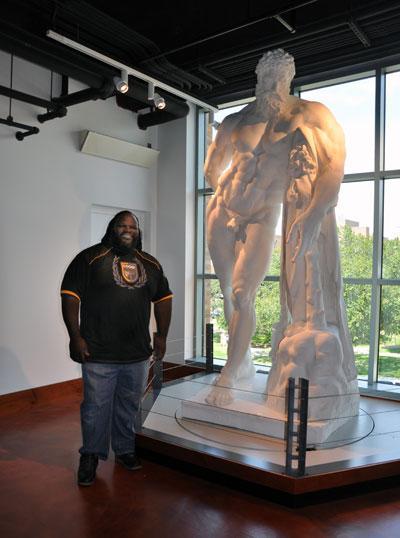Now that we’re at least partly open and thus able to show people around, we’ve been having visitors to the Stark Center. Sometimes the visitors are expected; sometimes they’re either not or at least not expected in the particular way they come. For example, just over a week ago I was very surprised as I walked past the elevator lobby where our full-size copy of the Farnese Hercules is displayed. What surprised me was that approximately 40 UT students were either sitting on benches or the floor or just standing in front of the immense, slowly-turning statue. They were not talking and they were not moving around. They were, in fact, quite still—as if they were at a religious service or a funeral.
That there were students looking at the Hercules was not what surprised me, however, since we’d been visited a few weeks earlier by a Professor of Art History who expressed his delight that the Stark Center—which is directly across the street from the Art Department—had on display a half dozen copies of classical statuary (discussed in an earlier blog) as well as the rotating giant standing hard by our outermost window. “I’m going to assign my students to come here and look at these wonderful statues,” the professor said, and in a week or so I began to see a student or two or three sitting quietly in our lobby and taking an occasional note. When I sat down by one of these first visitors, who was there alone, I asked him what his assignment had been and he said that the professor had instructed the class to spend at least 30 minutes contemplating the statues and to write down what they thought about what they were seeing. The student said that the professor explained that he wanted their hand-written first impressions and not something they typed after the fact.
Although I was pleased by this student’s visit and by what his professor had asked of the class, I wasn’t especially surprised, and in the coming days I saw others doing the same thing. But to see 40 students, all at once, almost filling the lobby and quietly studying a copy of a sculpture that was produced almost two thousand years ago was very, very gratifying. This is so because one of the reasons we went to the trouble and expense of acquiring the Farnese Hercules was so that visitors from the UT community and elsewhere could understand that considerations of physical culture have been part of human culture for a very long time. We also want these sculptures to be visually hortatory–to nonverbally exhort viewers to re-commit themselves to regular exercise and the consumption of healthy, strength-giving food. In other words, to embrace the physical culture life. Later, when we open the Weider Museum of Physical Culture and the rest of our galleries, we hope to do more such exhorting—both verbal and non-verbal– but for the time being visitors will have to be inspired by statues produced two millennia ago, a great long time before modern training systems, sophisticated exercise machines, easily loadable barbells and dumbells, research-based food supplements, and muscle-building drugs made the development of similar bodies significantly easier, if not in some cases healthier.
Finally, on a tangentially-related subject, a brief word about another recent visitor—a donor, in fact, to the Stark Center who, until a couple of weeks ago, had never seen the Hercules. That person has been like a member of our family for the past 20 years, ever since he came to us in 1990 as a teenager with a deep hunger to satisfy his extravagant dream of becoming the strongest man in the world—Mark Henry– who may very well have done exactly that back in the mid-1990s. This is neither the time nor the place to discuss Mark’s past right to such a significant and much-debated title, but it should suffice to say that he was when he came to us and he remains today a prodigiously strong man. I offer in partial explanation of my assertion a photograph that Jan took recently when Mark came to see some of the changes in the Stark Center. The photograph shows the 6’3”, 430-pound Henry standing next to the Hercules, and when I first saw the photo it looked odd to me–somehow out of scale. I was puzzled. But as I studied the photo I finally realized that what made it look so different from the scores of other shots of people standing next to the white giant was that—for the first and, so far, the only time—the Hercules doesn’t make the man standing alongside look like the child of a lesser god. For the first time, Hercules has met—although certainly not his match—a man who gives the impression of being both large and powerful. In time we hope to have other modern giants come to the Center, but we also welcome visitors of all sizes to come, to see, to learn, and to be inspired.
-Terry Todd




Leave your comment to Cancel Reply